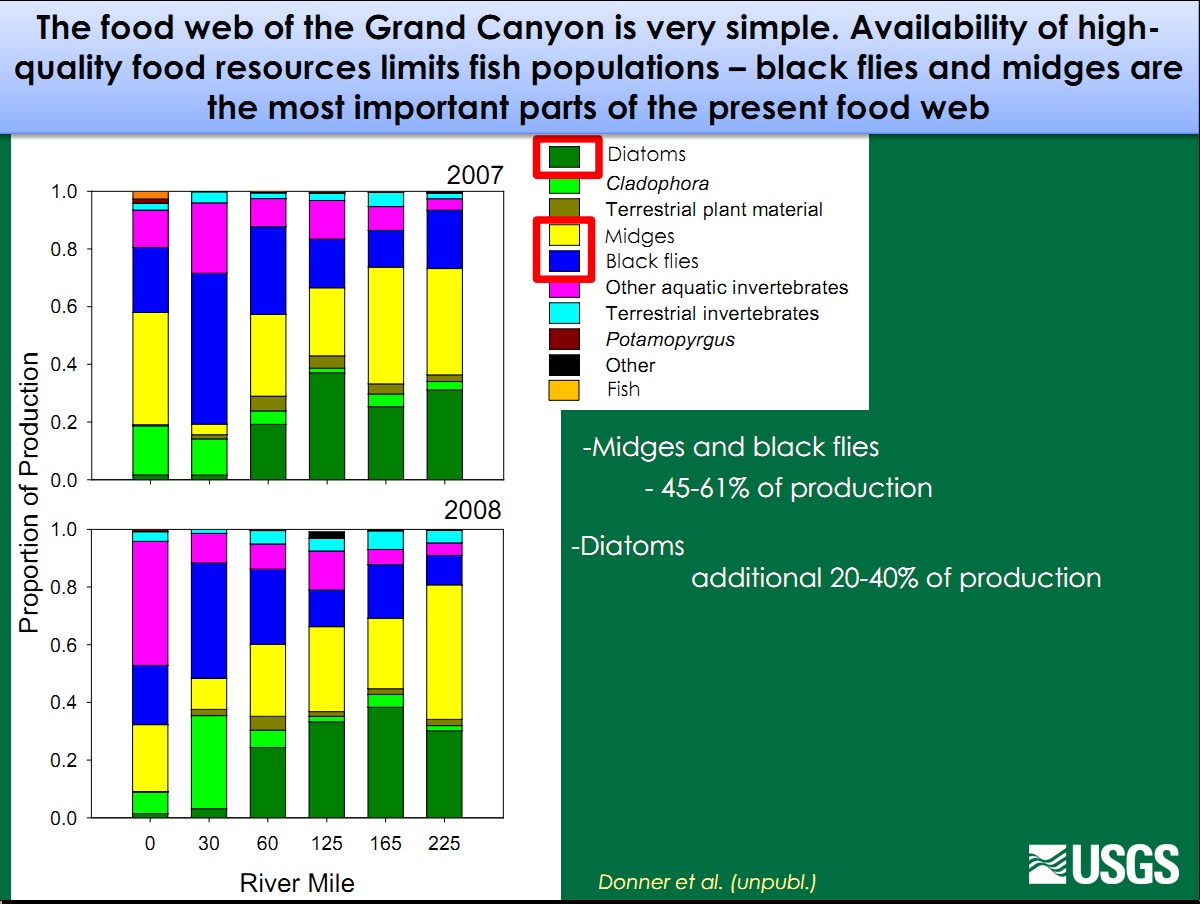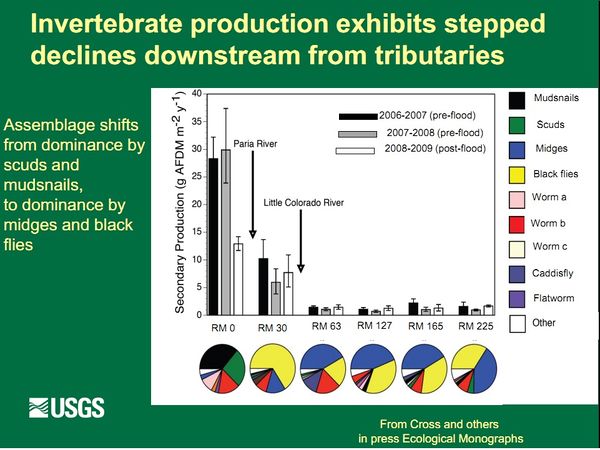Difference between revisions of "FOOD BASE"
Cellsworth (Talk | contribs) |
|||
| Line 21: | Line 21: | ||
------------Portal list on righthand side----------> | ------------Portal list on righthand side----------> | ||
|style="width:60%; font-size:95%;"| | |style="width:60%; font-size:95%;"| | ||
| − | + | [http://www.gcmrc.gov/research_areas/food_base/food_base_default.aspx USGS- GCMRC Definition] | |
The Colorado River below Glen Canyon Dam has been altered by dam-induced modifications to the river’s flow, temperature, and sediment supply. Nonnative species have also changed the natural system. Nonnative fish are thought to prey on and compete with native fish, including the endangered humpback chub (Gila cypha). These impacts have likely changed both the amount and sources of energy that fuel the aquatic food web and the flows of energy within the food web. Installation of the dam created a relatively clear, cool aquatic environment below the dam that now allows aquatic plants to capture the sun’s energy, and they in turn are now consumed by a few species, including scuds (Gammarus lacustris), midges (Family: Chironomidae), blackflies (Simulium arcticum), and New Zealand mudsnails (Potamopyrgus antipodarum). The first three species can provide food for both native and nonnative fishes, but fish cannot digest the New Zealand mudsnail. | The Colorado River below Glen Canyon Dam has been altered by dam-induced modifications to the river’s flow, temperature, and sediment supply. Nonnative species have also changed the natural system. Nonnative fish are thought to prey on and compete with native fish, including the endangered humpback chub (Gila cypha). These impacts have likely changed both the amount and sources of energy that fuel the aquatic food web and the flows of energy within the food web. Installation of the dam created a relatively clear, cool aquatic environment below the dam that now allows aquatic plants to capture the sun’s energy, and they in turn are now consumed by a few species, including scuds (Gammarus lacustris), midges (Family: Chironomidae), blackflies (Simulium arcticum), and New Zealand mudsnails (Potamopyrgus antipodarum). The first three species can provide food for both native and nonnative fishes, but fish cannot digest the New Zealand mudsnail. | ||
| Line 115: | Line 115: | ||
2013 | 2013 | ||
*'''[http://www.gcmrc.gov/about/foodbase/Cross%20et%20al._EM_2013.pdf Cross et al. 2013: Food-web dynamics in a large river discontinuum]''' | *'''[http://www.gcmrc.gov/about/foodbase/Cross%20et%20al._EM_2013.pdf Cross et al. 2013: Food-web dynamics in a large river discontinuum]''' | ||
| − | *'''[http://pubs.usgs.gov/fs/2013/3039/fs2013-3039.pdf Native and nonnative fish populations of the Colorado River are food limited - Evidence from new food web analyses]''' | + | *'''[http://pubs.usgs.gov/fs/2013/3039/fs2013-3039.pdf USGS fact sheet: Native and nonnative fish populations of the Colorado River are food limited - Evidence from new food web analyses]''' |
*'''[http://www.gcmrc.gov/about/foodbase/WellardKelley_et%20al.%202013.pdf Macroinvertebrate diets reflect tributary inputs and turbidity-driven changes in food availability in the Colorado River downstream of Glen Canyon Dam]''' | *'''[http://www.gcmrc.gov/about/foodbase/WellardKelley_et%20al.%202013.pdf Macroinvertebrate diets reflect tributary inputs and turbidity-driven changes in food availability in the Colorado River downstream of Glen Canyon Dam]''' | ||
| − | *'''[http://www.gcmrc.gov/about/foodbase/Kennedy%20et%20al.%20FWB%20proofs.pdf The relation between invertebrate drift and two primary controls, discharge and benthic densities, in a large regulated river]''' | + | *'''[http://www.gcmrc.gov/about/foodbase/Kennedy%20et%20al.%20FWB%20proofs.pdf Kennedy et al. 2013: The relation between invertebrate drift and two primary controls, discharge and benthic densities, in a large regulated river]''' |
2012 | 2012 | ||
Revision as of 14:52, 9 May 2016
|
|
The Colorado River below Glen Canyon Dam has been altered by dam-induced modifications to the river’s flow, temperature, and sediment supply. Nonnative species have also changed the natural system. Nonnative fish are thought to prey on and compete with native fish, including the endangered humpback chub (Gila cypha). These impacts have likely changed both the amount and sources of energy that fuel the aquatic food web and the flows of energy within the food web. Installation of the dam created a relatively clear, cool aquatic environment below the dam that now allows aquatic plants to capture the sun’s energy, and they in turn are now consumed by a few species, including scuds (Gammarus lacustris), midges (Family: Chironomidae), blackflies (Simulium arcticum), and New Zealand mudsnails (Potamopyrgus antipodarum). The first three species can provide food for both native and nonnative fishes, but fish cannot digest the New Zealand mudsnail.
|
| TBD (Motions) |
TBD (TBD) |
TBD (TBD) |
|---|

